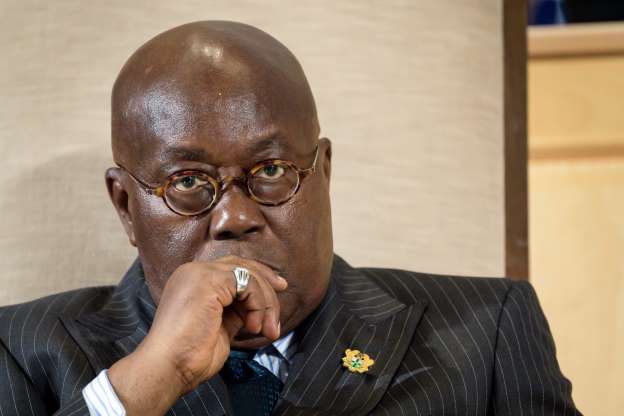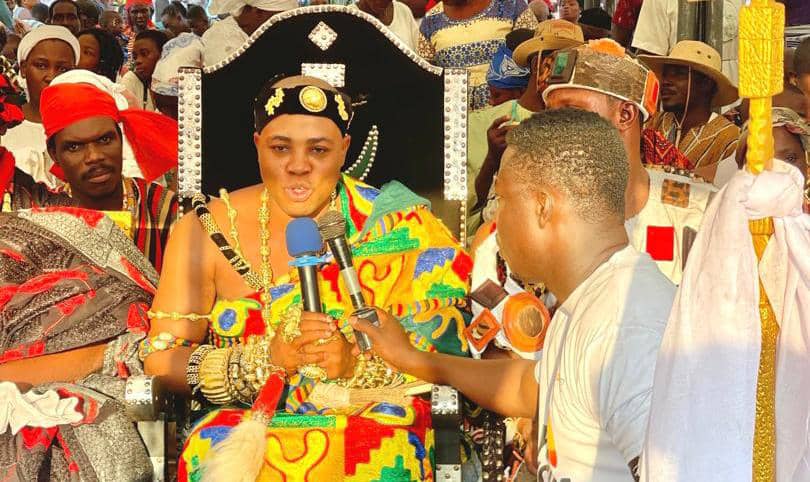The Mepe Traditional Council has disclosed that the Inter-Ministerial Committee set up by President Akufo-Addo to oversee the aftermath of the floods caused by the Akosombo Dam spillage, is yet to engage its outfit.
The Council says the Committee has neither contacted any of its members nor the Mepe Development Association (MDA) to engage them on the way forward, almost a year after the floods.
The victims of what many have described as the man-made disaster, according to the Council, have still not been compensated despite government’s claim of allocating some millions of cedis to them.
Speaking on behalf of the Traditional Council at the 68th Mepe Afenorto Festival durbar Saturday, August 10, 2024, Torgbe Korsi Nego VI, Manklalo of the Mepe Traditional Area, called on the President to resettle those displaced and compensate them.
“We are aware that during the flood disaster, the President of Ghana, H.E.
Nana Addo Danquah Akufo-Addo set up an Inter-Ministerial Committee to
attend to the fallouts of the flood disaster.
“Sadly, the committee is yet to engage with the Mepe Traditional Council and the Mepe Development Association to agree on the way forward in alleviating the plights of displaced persons and affected businesses.
“We request that the State should cause compensation and resettlement of the affected flood victims of Mepe and other communities in Lower Volta without delay. Mr. Chairman, almost a year into this devastating flood disaster without any meaningful state support coupled with the neglect of duty of care to the people is totally unacceptable,” Torgbe Nego indicated.
He called on the State actors to exhibit commitment to end the disaster. “We need to find a lasting and sustainable solution to the flood disaster. We need actions. We want to see the commitment of the State to this noble call.”
The Akosombo Dam spillage
Residents of the North Tongu district, especially those from the Mepe community, suffered severe consequences of the Akosombo Dam spillage, a crisis that displaced thousands of indigenous people in the affected areas.
The Akosombo Dam, with its staggering 150 billion cubic meters storage capacity and a maximum operating level of 276 feet, has long been a crucial source of hydroelectric power for Ghana.
A significant increase in rainfall, according to managers of the Dam, the Volta River Authority (VRA), pushed water levels beyond the dam’s maximum operating capacity. According to the VRA, the Dam was faced with the risk of failure, therefore necessitating the spillage.
The exercise commenced on September 15, 2023, initially at a discharge rate of 183,000 cubic feet per second (cfs/day), which was later increased on October 9 due to the continued rise of the water level.
With the town of Mepe being the hardest-hit community, initial reports indicated that 8,000 individuals were displaced across eight communities, but the numbers skyrocketed to an alarming 31,000 as of October 19 2023. Families have been uprooted from their homes, losing their belongings and sources of livelihood overnight.
The spillage also had a profound impact on education in the region. Schools were forced to close, leaving pupils and students without access to education. The interruption in learning could have long-term consequences for the affected children, depriving them of their right to education and hindering their future prospects.
Calls came for the government to provide immediate assistance, including temporary shelter, food, clean water, and medical aid, to alleviate the suffering of affected communities.
About the Akosombo Dam
The Akosombo Dam, also known as the Volta Dam, is a hydroelectric dam on the Volta River in southeastern Ghana in the Akosombo gorge and part of the Volta River Authority.
The primary purpose of the Akosombo Dam was to provide electricity for the aluminium industry. The Akosombo Dam is the largest single investment in the economic development plans of Ghana. The dam is significant for providing both Togo and Benin’s electricity, although the construction of the Adjarala Dam (on Togo’s Mono River) hopes to reduce these countries’ reliance on imported electricity. The dam’s original electrical output was 912 megawatts (1,223,000 hp), which was upgraded to 1,020 megawatts (1,370,000 hp) in a retrofit project that was completed in 2006.
In 1961, the Volta River Authority (VRA) was established by Ghana’s Parliament through the passage of the Volta River Development Act. The VRA’s fundamental operations were structured by six board members with Ghana’s first President Dr. Kwame Nkrumah as Chairman.
The construction of the Akosombo Dam resulted in the flooding of part of the Volta River Basin and its upstream fields, and in the creation of Lake Volta which covers 3.6% of Ghana’s total land area.
Lake Volta was formed between 1962 and 1966 and necessitated the relocation of about 80,000 people, who represented 1% of the population. People of 700 villages were relocated into 52 resettlement villages two years prior to the dam’s completion; the resettlement programme was under the direction of the VRA.
The last time the Akosombo Dam community experienced flooding as a result of a controlled spillage of the dam was in 2010.













